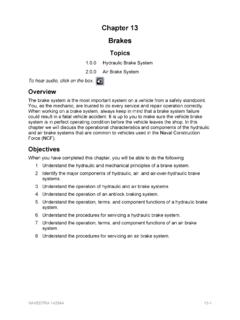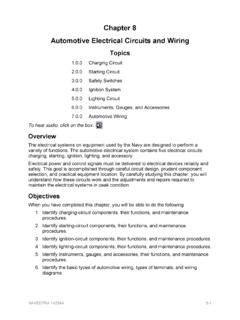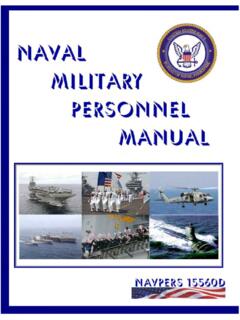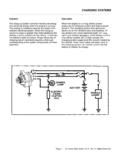Transcription of Chapter 5 Diesel Fuel Systems - Seabee Online
1 Chapter 5 Diesel Fuel Systems Topics Diesel Fuel Systems Methods of Injection Superchargers and Turbochargers Cold starting Devices Diesel Fuel system Maintenance general Troubleshooting To hear audio, click on the box. Overview Maintenance personnel form part of an important network of dedicated people who ensure that medium and heavy-duty trucks and construction equipment are maintained in safe and acceptable performance conditions. The Diesel fuel injection system is a major component of a properly operating engine. An engine out of adjustment can cause excessive exhaust smoke, poor fuel economy, heavy carbon buildup within the combustion chambers, and short engine life. In this Chapter you will learn the major components of the Diesel fuel system and how they operate so you may better maintain or have the knowledge to repair a Diesel engine.
2 Objectives When you have completed this Chapter , you will be able to do the following: 1. Understand the different types of Diesel fuel Systems , how the components function to provide fuel to the engine, and how to service Diesel fuel Systems . 2. Identify the properties of Diesel fuel. 3. Understand the function and operation of governors and fuel system components. 4. Understand the principles and operation of the different Diesel fuel Systems . 5. Understand the operation of and the differences between superchargers and turbochargers. 6. Identify the different types of cold weather starting aids. 7. Understand the basic maintenance required for a Diesel fuel system . 8. Understand general troubleshooting techniques used in the maintenance of a Diesel fuel system . NAVEDTRA 14264A5-1 Prerequisites None This course map shows all of the chapters in Construction Mechanic Basic.
3 The suggested training order begins at the bottom and proceeds up. Skill levels increase as you advance on the course map. Automotive Chassis and Body Brakes Construction Equipment Power Trains C Drive Lines, Differentials, Drive Axles, and Power Train Accessories M Automotive Clutches, Transmissions, and Transaxles Hydraulic and Pneumatic Systems Automotive Electrical Circuits and Wiring B A Basic Automotive Electricity S Cooling and Lubrication Systems I Diesel Fuel Systems C Gasoline Fuel Systems Construction of an Internal Combustion Engine Principles of an Internal Combustion Engine Technical Administration Features of this Manual This manual has several features which make it easy to use Online . Figure and table numbers in the text are italicized. The figure or table is either next to or below the text that refers to it.
4 The first time a glossary term appears in the text, it is bold and italicized. When your cursor crosses over that word or phrase, a popup box displays with the appropriate definition. Audio and video clips are included in the text, with italicized instructions telling you where to click to activate it. Review questions that apply to a section are listed under the Test Your Knowledge banner at the end of the section. Select the answer you choose. If the NAVEDTRA 14264A5-2answer is correct, you will be taken to the next section heading. If the answer is incorrect, you will be taken to the area in the Chapter where the information is for review. When you have completed your review, select anywhere in that area to return to the review question. Try to answer the question again. Review questions are included at the end of this Chapter . Select the answer you choose.
5 If the answer is correct, you will be taken to the next question. If the answer is incorrect, you will be taken to the area in the Chapter where the information is for review. When you have completed your review, select anywhere in that area to return to the review question. Try to answer the question again. NAVEDTRA Diesel FUEL Systems Like the gasoline engine, the Diesel engine is an internal combustion engine using either a two- or four -stroke cycle. Burning or combustion of fuel within the engine cylinders is the source of the power. The main difference in a Diesel engine is that the Diesel fuel is mixed with compressed air in the cylinder as shown in Figure 5-1. Compression ratios in the Diesel engine range between 6:1 for a stationary engine and 24:1 for passenger vehicles. This high ratio causes increased compression pressures of 400 to 600 psi and cylinder temperatures reaching 800 F to 1200 F.
6 At the proper time, the Diesel fuel is injected into the cylinder by a fuel-injection system , which usually consists of a pump, fuel line, and injector or nozzle. When the fuel oil enters the cylinder, it will ignite because of the high temperatures. The Diesel engine is known as a compression-ignition engine, while the gasoline engine is a spark-ignition engine. The speed of a Diesel engine is controlled by the amount of fuel injected into the cylinders. In a gasoline engine, the speed of the engine is controlled by the amount of air admitted into the carburetor or gasoline fuel injection Systems . Mechanically, the Diesel engine is similar to the gasoline engine. The intake, compression, power, and exhaust strokes occur in the same order. The arrangement of the pistons, connecting rods, crankshaft, and engine valves is about the same. The Diesel engine is also classified as in-line or v-type.
7 In comparison to the gasoline engine, the Diesel engine produces more power per pound of fuel, is more reliable, has lower fuel consumption per horsepower per hour, and presents less of a fire hazard. These advantages are partially offset by higher initial cost, heavier construction needed for its high compression pressures, and the difficulty in starting which results from these pressures. Diesel Fuel Diesel fuel is heavier than gasoline because it is obtained from the residue of the crude oil after the more volatile fuels have been removed. As with gasoline, the efficiency of Diesel fuel varies with the type of engine in which it is used. By distillation, cracking, and blending of several oils, a suitable Diesel fuel can be obtained for all engine operating conditions. Using a poor or improper grade of fuel can cause hard starting , incomplete combustion, a smoky exhaust, and engine knocks.
8 Figure 5-1 Diesel and gasoline ingines intake strokes. NAVEDTRA 14264A5-4 The high injection pressures needed in the Diesel fuel system result from close tolerances in the pumps and injectors. These tolerances make it necessary for the Diesel fuel to have sufficient lubrication qualities to prevent rapid wear or damage. It must also be clean, mix rapidly with the air, and burn smoothly to produce an even thrust on the piston during combustion. Diesel Fuel Oil Grades Diesel fuel is graded and designated by the American Society for Testing and Materials (ASTM), while its specific gravity and high and low heat values are listed by the American Petroleum Institute (API). Each individual oil refiner and supplier attempts to produce Diesel fuels that comply as closely as possible with ASTM and API specifications. Because of different crude oil supplies, the Diesel fuel may be on either the high or low end of the prescribed heat scale in BTU per pound or per gallon.
9 Because of the deterioration of Diesel fuel, only two grades of fuel are considered acceptable for use in high-speed heavy-duty vehicles. These are the No. 1D or No. 2D fuel oil classification. Grade No. 1D comprises the class of volatile fuel oils from kerosene to the intermediate distillates. Fuels within this classification are applicable for use in high -speed engines in service involving frequent and relatively wide variations in loads and speeds. In cold weather conditions, No. 1D fuel allows the engine to start easily. In summary, for heavy-duty high-speed Diesel vehicles operating in continued cold -weather conditions, No. 1D fuel provides better operation than the heavier No. 2D. Grade No. 2D includes the class of distillate oils of lower volatility. They are applicable for use in high -speed engines in service involving relatively high loads and speeds.
10 This fuel is used more by truck fleets due to its greater heat value per gallon, particularly in warm to moderate climates. Even though No. 1D fuel has better properties for cold weather operations, many still use No. 2D in the winter, using fuel heater/water separators to provide suitable starting , as well as fuel additive conditioners, which are added directly into the fuel tank. Selecting the correct Diesel fuel is a must if the engine is to perform to its rated specifications. Generally, seven factors must be considered in the selection of a fuel oil: starting characteristics Fuel handling Wear on injection equipment Wear on pistons Wear on rings, valves, and cylinder liners Engine maintenance Fuel cost and availability Other considerations in the selection of a fuel oil are as follows: Engine size and design Speed and load range Frequency of load and speed changes Atmospheric conditions NAVEDTRA Cetane Number Cetane number is a measure of the fuel oil s volatility; the higher the rating, the easier the engine will start and the smoother the combustion process will be within the ratings specified by the engine manufacturer.


















